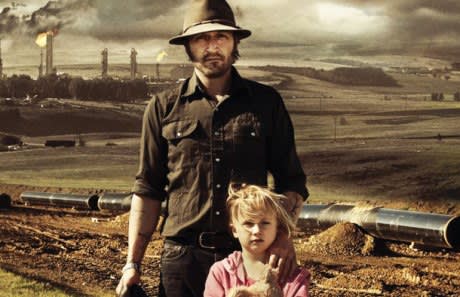Back in 2008, just outside of Dawson Creek, BC, reports of dying animals and sick children were being linked to sour gas leaks — natural gas that contains hydrogen sulphite — from pipelines belonging to EnCana Corp.
Shortly thereafter, anonymous letters were written to the Dawson Creek Daily News and other local publications, threatening the company with aggressive action. Said action occurred when six explosions went off, sabotaging the pipelines and starting an ideological war.
Julian T. Pinder's artfully stylized, impressionistic documentary, Trouble in the Peace, isn't interested in detailing the sheer facts about the incident. Noting the unfolding chaos and secrecy that occurred when EnCana offered a one-million dollar reward to anyone that could identify the bomber, Pinder's film is more interested in capturing the gradual decline of the quiet life of traditional agriculture in favour of mass corporate conglomerates and pre-packaged instant gratification.
Cattle farmer Karl Mattson worries about the future of his young daughter, looking after a sick dog and having watched a two-headed calf breathe life for only brief moments before succumbing to the inevitable. He creates art from these mutations, when not getting the run around from the gas company, unwilling to explain how, or why, a hole emitting sour gas was found in a pipe near his farm.
Pinder's style is mostly contemplative, featuring close-ups of his subjects reacting to situations, occasionally in forced set-ups shot as a composition to capture rural life. But it's also more cinematic than most docs, featuring a scene where the camera follows the trail of gas from the pipes to a farmhouse, adding a visceral component to associate a feeling with an idea.
Voiceovers about the death of agriculture and interviews about the frustration of not being able to live a quiet life without corporate impediment form the tone of Trouble, as does the nature of a community offended by the bureaucratic sense of urgency in finding a bomber while not caring about their many health complaints.
As such, the avoidance of talking heads and overt scare tactics is a refreshing approach. Pinder captures the despondence and sense of fear stemming from the impending death of the traditional farm with the appropriate sense of stillness and reflection.
It's just unfortunate that he's also heavy-handed in his application of melodrama and somewhat pretentious in many of the set-ups, making some potentially heartfelt moments strained and affected via his deliberately oblique attempts to add severity to otherwise banal situations. Still, his risk-taking is commendable, as is much of the cinematography, especially considering how dry his previous effort, Land, was.
As a companion to the film, Pipe Trouble (a videogame wherein you try to construct pipes over farmland without disrupting too many natural resources, inciting protests and bombs) is available online and for the iPad.
It's far more amusing and entertaining than a videogame for an eco-doc should be, having protesters block your progress in time trials if you cut down trees or interfere with wildlife.
(Kinosmith)Shortly thereafter, anonymous letters were written to the Dawson Creek Daily News and other local publications, threatening the company with aggressive action. Said action occurred when six explosions went off, sabotaging the pipelines and starting an ideological war.
Julian T. Pinder's artfully stylized, impressionistic documentary, Trouble in the Peace, isn't interested in detailing the sheer facts about the incident. Noting the unfolding chaos and secrecy that occurred when EnCana offered a one-million dollar reward to anyone that could identify the bomber, Pinder's film is more interested in capturing the gradual decline of the quiet life of traditional agriculture in favour of mass corporate conglomerates and pre-packaged instant gratification.
Cattle farmer Karl Mattson worries about the future of his young daughter, looking after a sick dog and having watched a two-headed calf breathe life for only brief moments before succumbing to the inevitable. He creates art from these mutations, when not getting the run around from the gas company, unwilling to explain how, or why, a hole emitting sour gas was found in a pipe near his farm.
Pinder's style is mostly contemplative, featuring close-ups of his subjects reacting to situations, occasionally in forced set-ups shot as a composition to capture rural life. But it's also more cinematic than most docs, featuring a scene where the camera follows the trail of gas from the pipes to a farmhouse, adding a visceral component to associate a feeling with an idea.
Voiceovers about the death of agriculture and interviews about the frustration of not being able to live a quiet life without corporate impediment form the tone of Trouble, as does the nature of a community offended by the bureaucratic sense of urgency in finding a bomber while not caring about their many health complaints.
As such, the avoidance of talking heads and overt scare tactics is a refreshing approach. Pinder captures the despondence and sense of fear stemming from the impending death of the traditional farm with the appropriate sense of stillness and reflection.
It's just unfortunate that he's also heavy-handed in his application of melodrama and somewhat pretentious in many of the set-ups, making some potentially heartfelt moments strained and affected via his deliberately oblique attempts to add severity to otherwise banal situations. Still, his risk-taking is commendable, as is much of the cinematography, especially considering how dry his previous effort, Land, was.
As a companion to the film, Pipe Trouble (a videogame wherein you try to construct pipes over farmland without disrupting too many natural resources, inciting protests and bombs) is available online and for the iPad.
It's far more amusing and entertaining than a videogame for an eco-doc should be, having protesters block your progress in time trials if you cut down trees or interfere with wildlife.
